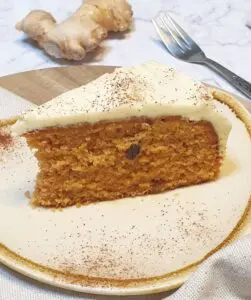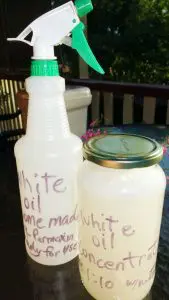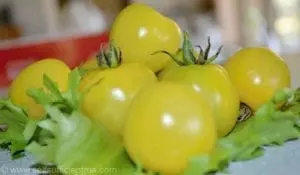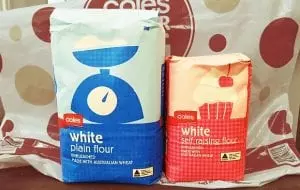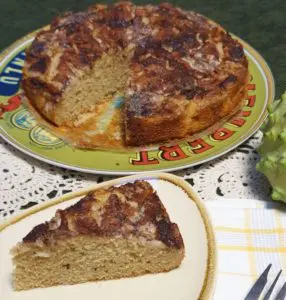Introduction
Plucking a fruit from your own tree or bush; there's nothing like the taste and satisfaction of doing such a task. The freshness and flavour not lost to travel or disruption and the pride in knowing you've helped create this treat from nature is what keeps us food gardeners out there working the land. Harvesting the perfect mango, apple, carrot or cob of corn from your own backyard is a feeling of achievement difficult to explain to a non-gardener.
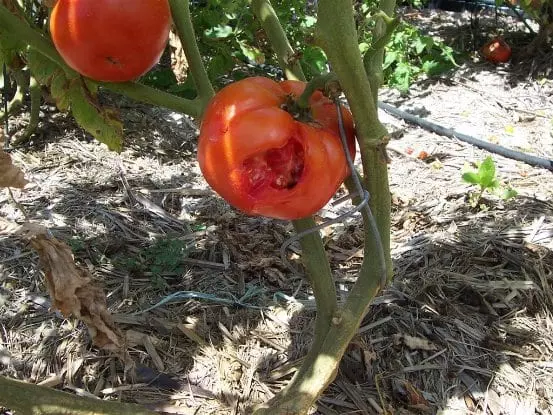
Bird Damage in a Tomato – Netting Prevents This From Happening
However, (and there's always an “however” in gardening) other beings besides us love what nature bares too and sometimes if we don't do something about it we can lose the competition to grab our rightful harvest. And, when that happens the disappointment of losing your precious crop to animals can be great, because no one likes to work hard on any endeavour for nil return. Even worse, is crop damage where perfectly good fruit and vegetables have holes pecked in or are removed from the plant prematurely and left on the ground.
Natives
For most of us it's our local native wildlife stealing our bounty. I have a particular problem with a possum and her young one that live in a tall ironbark tree in my yard. They come out at night and just love chewing the leaves off my spinach and they've even eaten the new growth from chilli plants! So manic they are to get my spinach, that I've seen them pushing furry black little noses against the netting forcing it in to get the tiniest bite of green.
Usually, these creatures have enough to eat from the natural environment, but given the choice of a juicy peach or fat spinach leaves over a few tiny native foliage shoots, I know which one I'd choose. Unfortunately, something like a peach doesn't even have to be juicy for these guys to eat it. They're quite happy gnawing on fruit just turning ripe, so to beat them to the fruit we'd have to pick it green and for most fruit this action isn't optimal.
Actions to Prevent Animals Eating Our Crops
Therefore, we need to take other actions to protect our food from being poache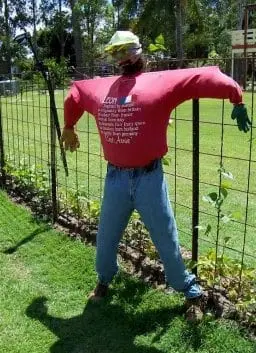 d. This is where netting becomes the fruit and vegetable gardeners best friend. Before we look at netting though, let's take a gander at some other common methods to stop animals eating our fruit and veg:
d. This is where netting becomes the fruit and vegetable gardeners best friend. Before we look at netting though, let's take a gander at some other common methods to stop animals eating our fruit and veg:
-
Scarecrow – Fail: don't work (well mine didn't…I guess he wasn't very scary). We did have fun making him with the kids though.
-
Automatic motion water spurt-er – Fail: wastes water, batteries, and turns into a sprinkler on a windy day/night because it thinks every moving branch is an animal.
-
Fake snake or bird of prey – Fail: most animals know it's a sham, and you're likely to forget about it until you or visiting Grandma takes a leisurely garden stroll and dies of shock by inevitably looking up and seeing a snake in the tree.
-
Shiny CD hanging – Fail: just an annoying eye catcher for humans. I've seen birds sit right next to them.

-
Running out clapping your hands and yelling – Works: but very inconsistent and no good in the dark or early morning in your undies when the neighbours can see you.
-
Vicks Vapour Rub (a camphor gel to help with cold and flu symptoms) – Works: only for awhile, however, the stuff is expensive, it's messy smearing the gel around, washes off in the rain, and won't repel birds.
-
Re-location – Works: again only for awhile until the animal comes back or another moves in. And, it also doesn’t apply to birdies. Note: Be careful handling wildlife, they can carry disease and give very nasty bites and scratches – it's usually best left to the pros.
Apple Trees Bird Netting
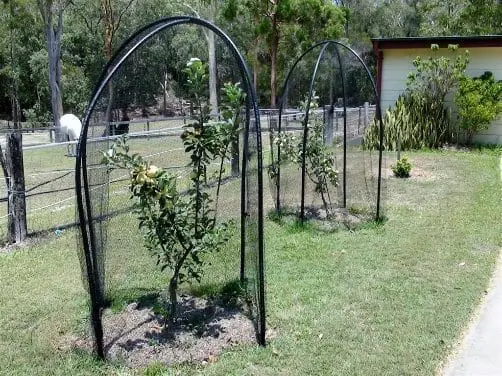
Types of Netting Methods
Nope, netting is by far the best and most humane method of limiting “crop damage” from animals. There are different types of netting methods and some are:
-
Permanent orchard netting – very effective, but used mainly commercially and is expensive because the whole growing area is covered by a permanent structural frame and net.
-
Drape netting – where a net is loosely draped over a tree or plant without a structure. This method can be effective and easy; however, the loose hang of the net can increase the risk of harming wildlife through tangling. Also, the net is resting on the branches and foliage possibly causing damage. Best used for small trees or plants and only for as long as necessary.
-
Garden fabric – a lightweight cloth (like tough tissue). Good product, can be used to drape over rows of vegetables directly (not large plants or trees) or used with frames and excludes insects as well, which can be problematic for plants requiring pollination to fruit.
-
Bagging – Similar material to g
 arden fabric but instead of covering the whole plant only the fruit is bagged by using various sleeves and ties to cover the fruit. Works ok and many people like this method; all the same, I find it can become expensive, difficult to implement for many fruits on one plant, time consuming, annoying to remove bag and check fruit, foliage tends to get damaged or rot and fall into bag, and larger animals tear the bag and get the fruit anyway.
arden fabric but instead of covering the whole plant only the fruit is bagged by using various sleeves and ties to cover the fruit. Works ok and many people like this method; all the same, I find it can become expensive, difficult to implement for many fruits on one plant, time consuming, annoying to remove bag and check fruit, foliage tends to get damaged or rot and fall into bag, and larger animals tear the bag and get the fruit anyway. -
Open tunnel – for garden beds or trellises requiring regular access. The netting is placed over a frame open at each end like a tunnel. I've used this method successfully for several years by “deterring” not totally excluding animals. Surprisingly, I've found wildlife (especially birds) reluctant to enter under the netting and attack fruit but the advantage is I can enter easily and if animals do come in they simply wander straight out.

-
DIY frame netting total exclusion – where a temporary frame is made to hold the net off the tree or garden. Frames can be made from many different materials such as steel, poly irrigation hoses, PVC, wire, wood, etc. I've found irrigation hose to be the best, most cost effective, and easiest method to install. Netting is easy to buy from gardening centres or major retailers a 4m x 4m piece is enough to stretch-cover a raised garden bed 3m x 1.5m giving ample height. I've found the reasonably priced generic netting to be suffice and some of my nets are 5 plus years old and still in good condition.
Open Tunnel with Netting Over Top Works Surprisingly Well
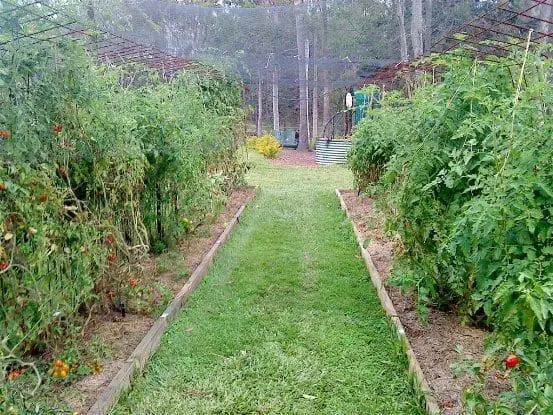
10 Things to Consider When Using Netting
Once you have decided on what netting method is best for you there are other things to take into consideration like:
-
Wildlife safety – You want to stop wild animals eating your fruit and vegetables NOT set a trap to kill. Therefore, it's best to stretch netting taught (as realistically possible) around the frame so wildlife can’t easily get tangled and if they run into the net a fright and bounce is about all that happens. Ensure there are no gaps in the netting where an animal can scurry under as they may get in but not out. And, check the nets regularly in case an animal is unfortunately trapped.
-
Erect netting – For fruit trees/shrubs, try to erect the netting after pollination so bees and other insects/animals aren’t inhibited from getting to the flowers.
-
Clearance – Allow adequate clearance for the plant to grow during the time the net will be in place as it may be there for several months. If branches are too close to the net and the net too loose birds and animals may still reach the fruit by pushing on the netting.

-
Net removal – For non-permanent netting when netting a tree or shrub remove it soon after the job is done otherwise the plant will grow through the net and it will be difficult to remove without damaging the plant and net.
-
Reuse – Netting should last several years. Pack-up, label, and put away for next season.
-
UV – Make sure the netting is UV treated or it won't last a few months in the sun and just be a waste of money.
-
Easy entry – Design permanent netting over small gardens with easy entry points like plastic hand clamps or pegs that are easy to remove to gain access to the crops. If access is difficult it will deter regular harvesting and be an annoyance rather than an enjoyable gardening experience.
-
Security – the frame should be pegged into the ground to withstand wind gusts and storms.
-
White or black coloured netting?
 Some believe white netting is easier for animals to see especially at night. I tend to use the black netting because it's easier to obtain from my local centre and I prefer the look of it. Fortunately, I have not had any wildlife caught in my netting to date.
Some believe white netting is easier for animals to see especially at night. I tend to use the black netting because it's easier to obtain from my local centre and I prefer the look of it. Fortunately, I have not had any wildlife caught in my netting to date. -
When to use? Only use netting if you have a problem with your crop being attacked. One or three fruits being eaten off a tree producing 100 in a season is not a problem and you may wish to accept these losses. My mandarin tree in season loses two or three fruit per week but the tree produces hundreds of fruit so I've never used netting because the losses are minimal compared with the expense and trouble of netting.
Conclusion
With a little effort and correct usage, netting will help in giving us the edge in winning the contest over who or what gets to the fruit and veg first. Sure, losing a few bites to our gorgeous native animals isn't a big deal; however, if your crops become a free-for-all (except you) then netting will definitely help and installing it will be worth the effort.

Apples Nice and Safe Under Netting – You Beauty!
I will be doing some follow-up posts on netting in the future. More specifically, a step-by-step how to for some of the netting methods I already use. I'm also currently working on designing a new frame method specifically for trees – I'll post it when I've finished the design and tested it.
If you have any netting ideas or methods you'd like to share with us feel free to comment below this post or use our forum and see what others think about it.
Thanks for reading and thanks for your support,
Look, and see the Earth through her eyes
Mark Valencia – Editor SSM


 arden fabric but instead of covering the whole plant only the fruit is bagged by using various sleeves and ties to cover the fruit. Works ok and many people like this method; all the same, I find it can become expensive, difficult to implement for many fruits on one plant, time consuming, annoying to remove bag and check fruit, foliage tends to get damaged or rot and fall into bag, and larger animals tear the bag and get the fruit anyway.
arden fabric but instead of covering the whole plant only the fruit is bagged by using various sleeves and ties to cover the fruit. Works ok and many people like this method; all the same, I find it can become expensive, difficult to implement for many fruits on one plant, time consuming, annoying to remove bag and check fruit, foliage tends to get damaged or rot and fall into bag, and larger animals tear the bag and get the fruit anyway. 

 Some believe white netting is easier for animals to see especially at night. I tend to use the black netting because it's easier to obtain from my local centre and I prefer the look of it. Fortunately, I have not had any wildlife caught in my netting to date.
Some believe white netting is easier for animals to see especially at night. I tend to use the black netting because it's easier to obtain from my local centre and I prefer the look of it. Fortunately, I have not had any wildlife caught in my netting to date. 